Education and Training - Economics and Employment
Explore the Education and Training sector data which highlights its contribution to the local economy on the Sunshine Coast.

The Sunshine Coast's Education and Training Industry shines brightly as a cornerstone of the region's vibrant economic and social fabric. This dynamic sector not only fuels local productivity but also shapes the future workforce with innovation and excellence. It’s significance is truly profound. This article explores and celebrates the current state of the Education and Training Industry on the Sunshine Coast, highlighting key aspects such as economic contributions, workforce qualifications, employment trends, wage levels, and export performance. By examining these elements, we aim to showcase the strengths, address the challenges, and envision a promising future for this essential industry. With a focus on continuous improvement and innovative practices, the Education and Training industry on the Sunshine Coast continues to play a pivotal role in the region's growth and development.
The sector was highlighted in the recent refresh (2023) of the Sunshine Coast Regional Economic Development Strategy (REDS) 2013 - 2033. The industry will play a vital role in helping the region achieve four key economic outcomes which includes growing the local Gross Regional Product to $33 billion.
Industry productivity
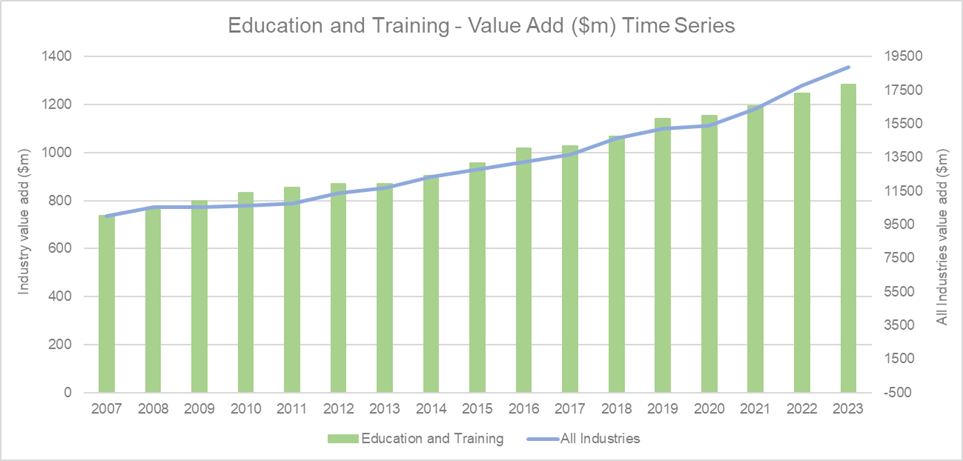
Source: National Institute of Economic and Industry Research (NIEIR) 2024. Compiled and presented by economy.id
The Education and Training Industry accounts for approximately 6.8 per cent of the total value added by all industries on the Sunshine Coast. This sector has shown resilience and growth, with its total value added increasing by 3.0 per cent from 2022 to 2023. This upward trend underscores the industry's crucial role in the region's economic landscape.
Industry workers qualifications
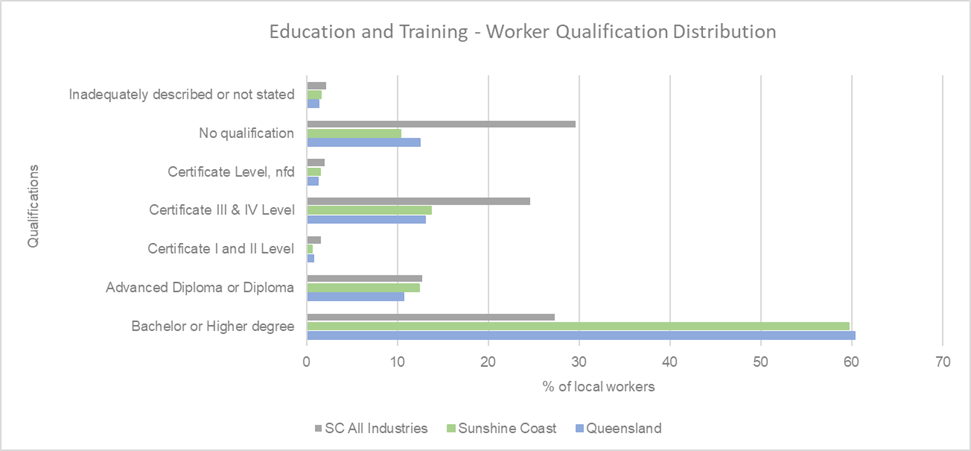
Source: Australian Bureau of Statistics, Census of Population and Housing 2021. Compiled and presented by economy.id)
The Education and Training Industry workforce on the Sunshine Coast is notably qualified, with 60 per cent holding a bachelor’s degree or higher. This reflects the industry’s dedication to excellence and the region’s emphasis on education. Only about 10 per cent of the workforce lacks formal qualifications, underscoring the necessity of higher education for participation in this sector.
Total employment time series
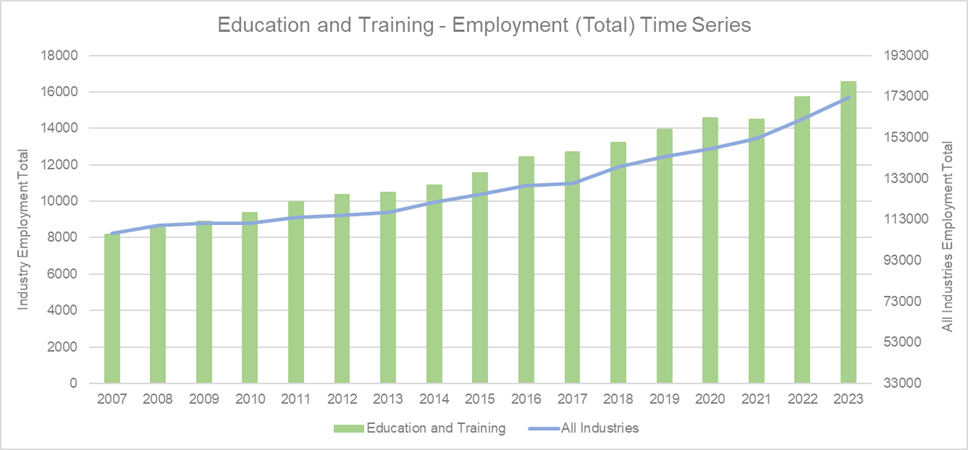
Source: National Institute of Economic and Industry Research (NIEIR) 2024. Compiled and presented by economy.id
Employment in the Education and Training Industry makes up about 9.6 per cent of all employment opportunities across the Sunshine Coast. The total number of jobs in this sector has risen by 5.5 per cent from 2022 to 2023, reflecting the growing demand for educational services and training programs. The industry’s highest employment level was reached in 2023 with 16,573 people making up the workforce. This increase in employment is a positive indicator of the industry's health and its capacity to provide stable job opportunities for residents.
Export and local sales

(Source: National Institute of Economic and Industry Research (NIEIR) 2024. Compiled and presented by economy.id)
The Sunshine Coast’s Education and Training industry's export performance differs from the state average. Its international exports are 7.37 per cent lower than the Queensland average, while domestic exports are 3.72 per cent lower, likely due to larger education offerings in more populated areas like Brisbane and the Gold Coast. However, Local sales are 11.09 per cent higher than the state, reflecting strong local demand for educational services and training programs.
Employee age and gender distribution
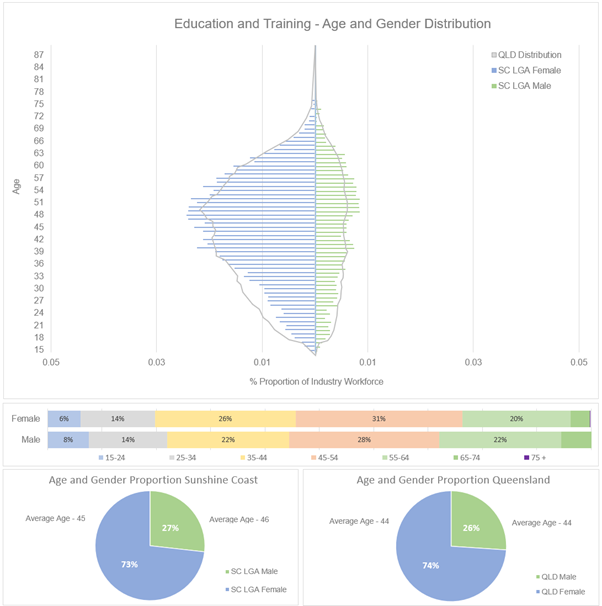
(Source: ABS Table Builder 2024, 2021 Census - employment, income, and education)
Females make up a significant portion of the workforce, accounting for 73 per cent of employees in the industry. The average age of workers is 46 years, with the 45-54 age group representing the largest segment at 31 per cent, followed by the 35-44 age group at 26 per cent. This demographic distribution indicates a mature and experienced workforce.
Industry business distribution
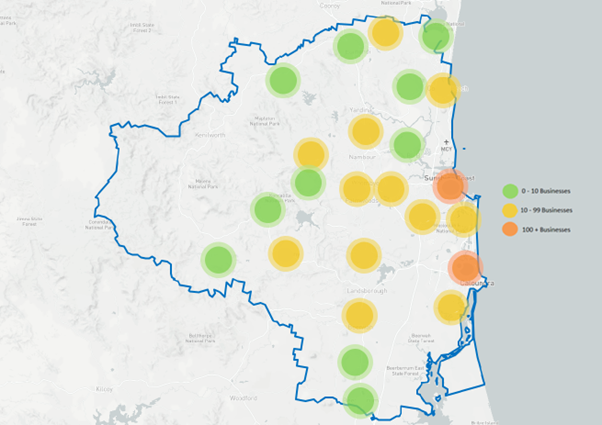
(Source: ABR 2024)
The Sunshine Coast is home to 739 education and training-based businesses, which are widely dispersed across the region. Maroochydore and Caloundra have the highest concentrations of these businesses, serving as key hubs for educational activities and training programs.
Disclaimer: ABS employment Data has this information grouped by larger selected suburbs. Smaller suburbs feed into the data set of these selected suburbs.
Employee income distribution
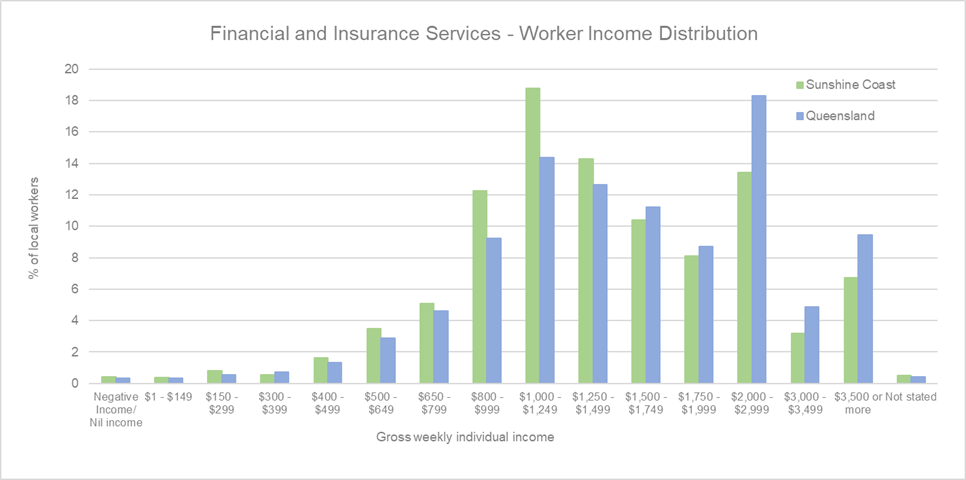
(Source: Australian Bureau of Statistics, Census of Population and Housing 2021. Compiled and presented by economy.id)
50 per cent of workers in the Education and Training Industry on the Sunshine Coast earn under $1,249 per week. The largest group of workers, representing 14.7 per cent of the workforce, earns between $2,000 - $2,999 per week. This wage distribution highlights the diverse earning potential within the industry, catering to a wide range of roles and responsibilities.
Job vacancies - Australia-wide
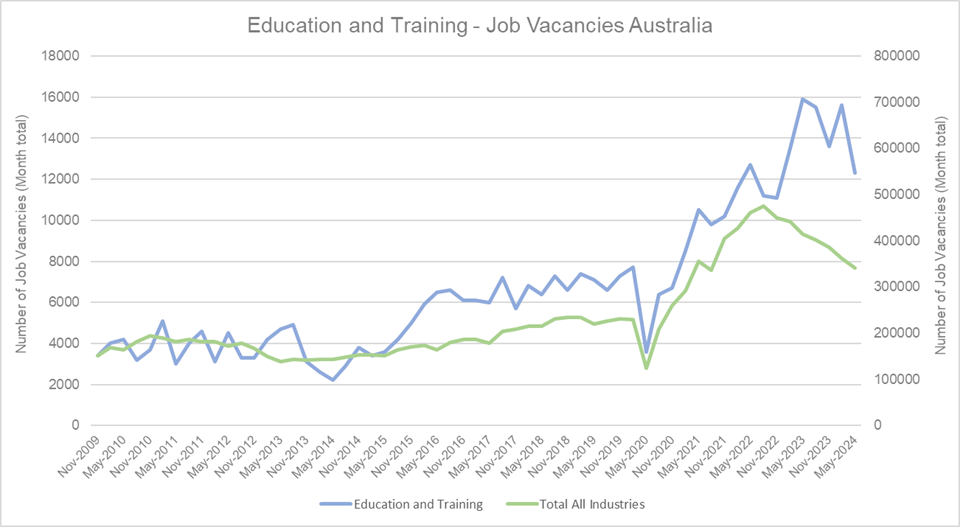
(Source: ABS 2024, Time Series – 6354 – Job Vacancies, Industry, Australia)
Job vacancies in the Education and Training Industry across Australia has behaved differently compared to other industries. While vacancies in most sectors gradually declined over the past two years, vacancies in education and training remained high. This trend suggests a sustained demand for skilled professionals in the sector, reflecting its critical role in the broader economy.
Conclusion
The Education and Training Industry on the Sunshine Coast is a vital and dynamic sector that significantly contributes to the region's economic and social well-being. With a highly qualified workforce, strong local demand, and a growing number of businesses, the industry is well-positioned to continue its positive trajectory. The sustained demand for skilled professionals and the industry's resilience highlights its critical role in the broader economy.
The Sunshine Coast Regional Economic Development Strategy (REDS) places a strong emphasis on education as a key driver of economic growth and community development. By prioritising talent attraction, retention, and development, the strategy aims to ensure that the region remains competitive and innovative. The industry will continue to be a cornerstone of the region's development, shaping the future workforce and supporting the community's aspirations as the Sunshine Coast continues to grow and evolve.
Resources and support
Disclaimer
Information contained in this correspondence is based on available information at the time of writing. All figures and diagrams are indicative only and should be referred to as such. While the Sunshine Coast Regional Council has exercised reasonable care in preparing this information it does not warrant or represent that it is accurate or complete. Council, its officers, and contractors accept no responsibility for any loss occasioned to any person acting or refraining from acting in reliance upon any material contained in this document. Any forecasts or projections used in the analysis can be affected by a number of unforeseen variables, and as such no warranty is given that a particular set of results will in fact be achieved. Sunshine Coast Regional Council has referenced a range of data sources to compile this information including the Australian Bureau of Statistics, Queensland Government Statistician’s Office, Tourism Research Australia, Economy Id and the National Institute of Economic and Industry Research. While every care has been taken to ensure the content is accurate, there may be errors or omissions in it and no legal responsibility is accepted for the information.
